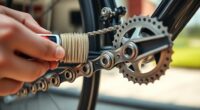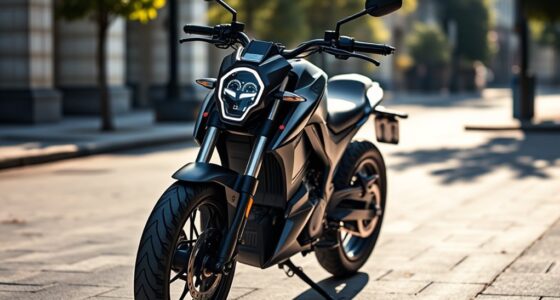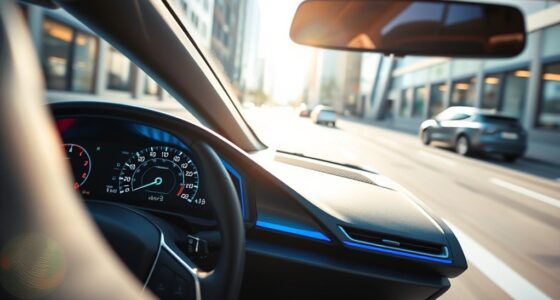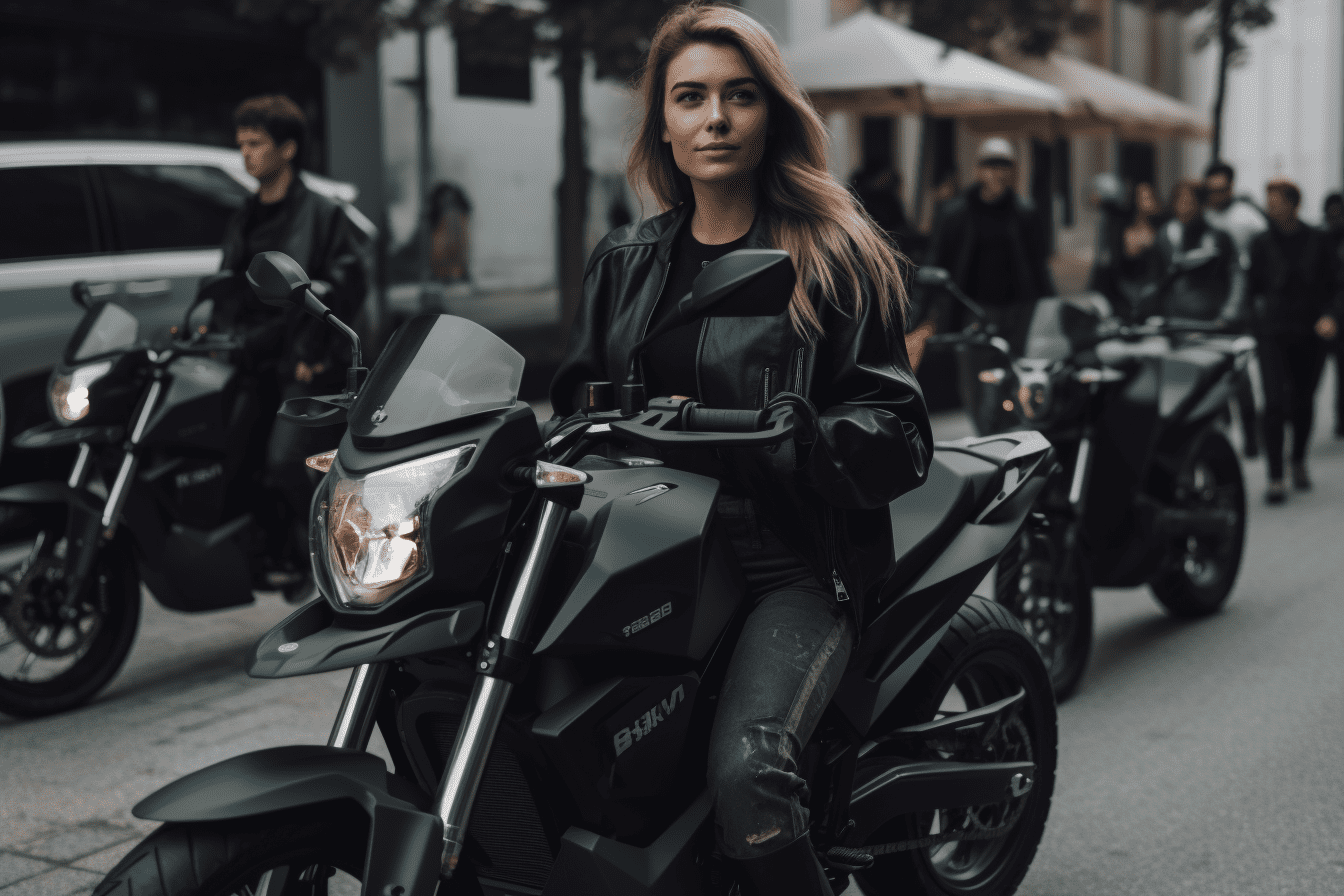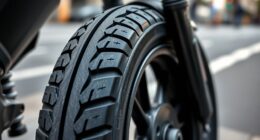To maximize your e-motorbike’s range, keep your speed moderate—around 15-20 mph—since higher speeds increase aerodynamic drag and battery drain. Riding faster, especially above 25 mph, quickly reduces efficiency and range. Focus on smooth, steady riding, and consider aerodynamic tweaks like fairings or crouched positions to cut wind resistance. Balancing speed and efficiency helps you go farther; explore more tips to extend your trip without sacrificing performance.
Key Takeaways
- Riding at moderate speeds (15-20 mph) maximizes range by reducing aerodynamic drag and energy consumption.
- Speeds above 25-30 mph drastically increase power demands, decreasing overall range.
- External factors like terrain, wind, and surface type significantly impact energy efficiency and range.
- Aerodynamic features and rider positioning can reduce wind resistance, extending riding distance.
- Balancing speed and environmental conditions ensures optimal range without sacrificing performance.
Understanding the Relationship Between Speed and Range
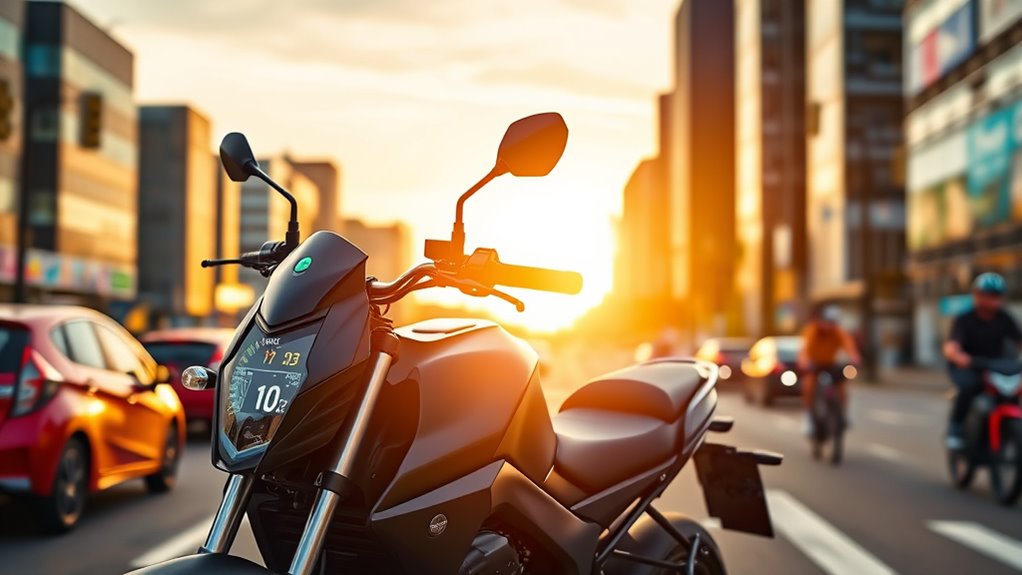
Understanding how speed affects your e-motorbike’s range is essential for making the most of your ride. As you increase speed from 10 mph to 30 mph, your range drops markedly—from about 46 miles down to just 8 miles—mainly due to increased aerodynamic drag. Higher speeds demand more power from the battery, which means you use energy more quickly. At around 30 mph, energy consumption reaches roughly 37 Wh/mile, sharply reducing how far you can go on a single charge. Wind resistance doubles with each 50% increase in speed, further cutting your range, especially against headwinds. To maximize miles, riding between 15-20 mph is ideal, where aerodynamic drag and power demands stay manageable, helping you get the most out of your battery. Additionally, understanding safety features and proper maintenance can help ensure your e-motorbike operates efficiently over time. Being aware of battery management practices can also prolong your battery’s lifespan and maintain optimal performance. Implementing efficient riding techniques can further enhance overall range and reduce energy consumption during your rides, especially when considering the impact of aerodynamic factors on your efficiency. Regularly monitoring your power consumption can help you adjust your riding style for better efficiency.
How Speed Affects Battery Consumption and Efficiency

As you increase your e-motorbike’s speed, your battery consumption rises sharply, making efficiency a key concern. At lower speeds around 10 mph, energy use is about 16 Wh/mi, but it jumps to over 37 Wh/mi at 30 mph, reducing your range. Doubling your speed considerably boosts aerodynamic drag, which in turn dramatically increases power demands. Riding at moderate speeds of 15-20 mph helps optimize efficiency, often lowering Wh/mi and extending battery life. When you push beyond 25 mph, aerodynamic drag can quadruple energy consumption, cutting your range considerably. To maintain higher speeds with less battery drain, aerodynamic factors like fairings and riding position matter. Noise levels of modern heat pumps and their design for quieter operation can serve as a reference for optimizing system performance and reducing environmental impact. Managing speed and minimizing drag are essential for maximizing efficiency and getting the most out of your e-motorbike’s battery. Additionally, understanding aerodynamic drag can help you adopt riding techniques that reduce resistance and improve overall efficiency. Proper aerodynamic design of your bike can significantly influence energy consumption at higher speeds. Recognizing the importance of lightweight materials can also contribute to better overall performance and range. Furthermore, selecting preppy dog names that reflect a sleek and stylish image can add a touch of sophistication to your riding experience.
The Role of Aerodynamics and Design in Range Optimization

Your bike’s shape and design play a vital role in extending its range. Streamlined bodies, fairings, and crouched riding positions reduce wind resistance, especially at higher speeds. Small design improvements can considerably boost efficiency and help you go farther on a single charge. Incorporating vintage decor elements into the bike’s aesthetic can also enhance its visual appeal while maintaining a classic look. Additionally, understanding how aerodynamics influence energy consumption can guide better design choices for maximizing range. Recognizing the importance of dynamic communication exercises can also foster better rider awareness and responsiveness, indirectly contributing to more efficient riding.
Streamlined Bike Shapes
Streamlined bike shapes play a crucial role in maximizing an e-motorbike’s range by cutting down aerodynamic drag. Lowracers and bent designs reduce wind resistance, making energy use more efficient. Adding fairings and aerodynamic fairings can lower drag by up to 50%, helping conserve battery power at higher speeds. Rider positioning, such as crouched or tucked postures, minimizes frontal area exposure, decreasing air resistance and boosting range. Smaller wheels and optimized frame geometries also improve airflow and reduce turbulence, especially at high speeds. Smooth surface finishes and integrated components further enhance aerodynamics. Additionally, understanding Honda Tuning techniques can inspire innovative design features that improve airflow and reduce turbulence. Implementing aerodynamic principles can significantly enhance overall efficiency, ensuring that the bike maintains optimal range during long rides. By focusing on streamlined shapes, you can extend your bike’s range without sacrificing performance, making it a smarter choice for those prioritizing efficiency and distance.
Fairings and Crouched Postures
Fairings and crouched postures are key to enhancing your e-motorbike’s aerodynamics and extending its range. Fairings streamline the bike’s shape, reducing aerodynamic resistance, especially at higher speeds, which can boost riding range by up to 20%. Adopting a crouched posture minimizes your frontal area, further decreasing resistance and conserving battery life. Lowracer or bent-bike designs combine fairings with an aerodynamic rider position, allowing sustained higher speeds with less energy consumption. Properly fitted fairings and a crouched posture lower the bike’s drag coefficient (Cd), directly improving energy efficiency and maximum range. These aerodynamic enhancements are most effective above 15 mph, where wind resistance becomes the dominant factor in energy expenditure. Enhancing airflow around the bike can also reduce the impact of aerodynamic drag, further enhancing efficiency. Incorporating lightweight materials and optimizing component placement can additionally contribute to better overall performance. Additionally, understanding range optimization strategies can help riders tailor their riding style and bike configuration for maximum efficiency. Implementing these design principles can also help mitigate other sources of inefficiency, such as mechanical losses and suboptimal weight distribution. Leveraging data-driven insights from personal development tools can also support consistent riding habits that maximize range and efficiency.
Managing Power and Speed: Tips for Extended Riding Distance
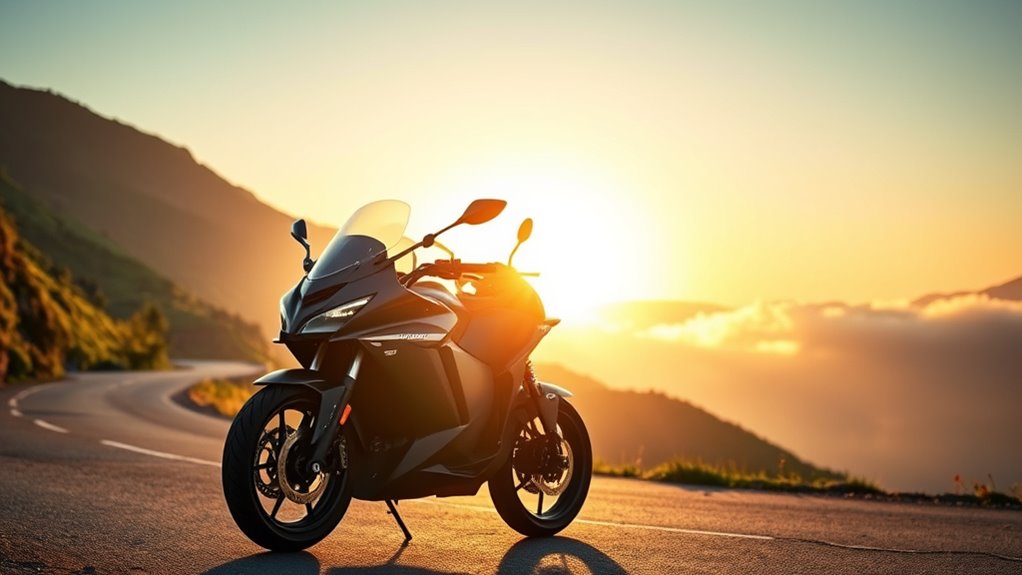
To maximize your e-motorbike’s range, managing your speed and power output is essential. Proper speed management and pedal assistance can considerably extend your ride. Here are some tips:
- Ride at lower speeds—15-20 mph—to reduce aerodynamic drag and conserve battery life.
- Use pedal assistance to decrease reliance on high motor power, aiding in range extension.
- Keep tire pressure ideal and choose aerodynamic accessories to lessen wind resistance.
- Avoid sudden accelerations and stops, which waste energy and drain the battery faster.
Impact of Terrain, Wind, and Surface on Range at Different Speeds

Your riding environment plays a significant role in how far your e-motorbike can go on a single charge. Wind, terrain, and surface affect energy use, especially at different speeds. Headwinds double wind resistance, increasing energy consumption and reducing range. Rough surfaces like dirt or snow boost rolling resistance, making your bike work harder. Uphill climbs demand 5 to 10 times more energy per mile, cutting your distance. Riding above 20–25 mph exponentially increases aerodynamic drag, sharply lowering range. Conversely, coasting downhill or on smooth surfaces minimizes energy use. Understanding these factors helps you optimize your ride:
| Terrain/Surface | Effect on Range | Speed Impact | Additional Notes |
|---|---|---|---|
| Flat, smooth | Less resistance | Moderate | Best for range |
| Uphill | Higher energy use | High | Shortens range |
| Dirt, snow | Increased rolling resistance | Moderate | Use caution |
| Headwinds | Doubles wind resistance | Any speed | Reduce speed |
| Downhill | Minimized energy use | Variable | Extend range |
Choosing the Right Speed for Daily Commutes and Long Rides
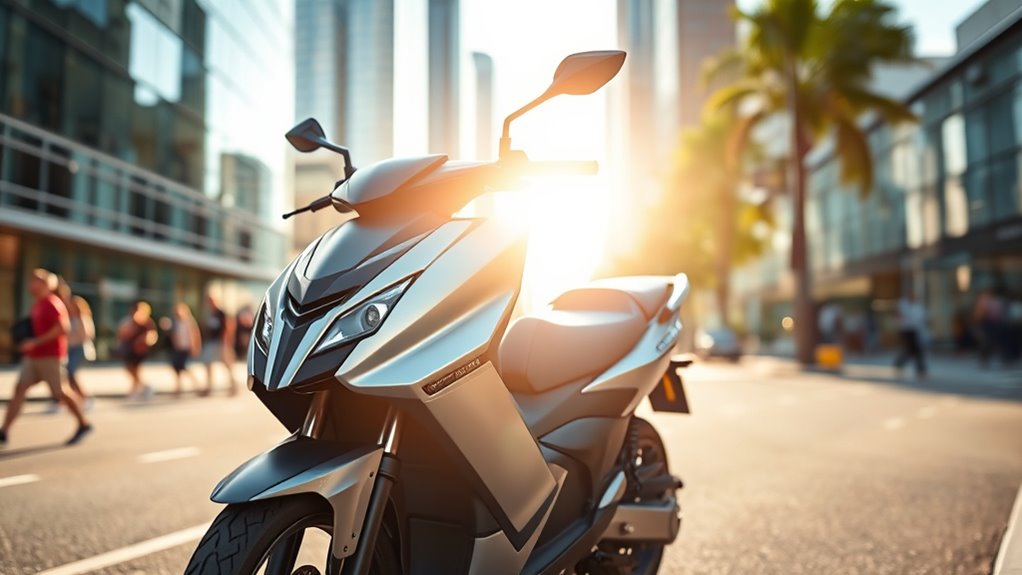
Choosing the right speed can substantially enhance your e-motorbike’s range during daily commutes and long rides. To maximize efficiency, focus on maintaining a speed that aligns with your battery capacity and trip goals. Here are four tips:
- Keep your speed between 15-20 mph to minimize aerodynamic drag and conserve energy.
- Avoid exceeding 30 mph, as energy use can quadruple, reducing your miles per hour covered per charge.
- For longer trips, sticking to 15-20 mph ensures steady range and prevents rapid battery drain.
- Adjust your speed based on terrain and traffic to optimize range without risking safety or comfort.
Balancing Top Speed and Practical Range for Your Riding Style

Balancing top speed with practical range requires understanding how speed impacts energy consumption. When you push your e-motorbike’s top speed higher, your range drops markedly because increased aerodynamic drag and energy use drain the battery faster. Riding at moderate speeds around 15-20 mph maximizes efficiency, letting you cover more distance on a single charge. Doubling your speed from 20 mph to 40 mph can require up to eight times more power, sharply reducing your usable range. To find the right balance, consider your typical riding conditions and how much range you need. Aerodynamic mods, like fairings or lower riding positions, can help maintain a higher top speed while optimizing efficiency. Aligning your top speed with your riding style ensures better battery life and a more satisfying ride.
Strategies to Maximize Range Without Sacrificing Performance
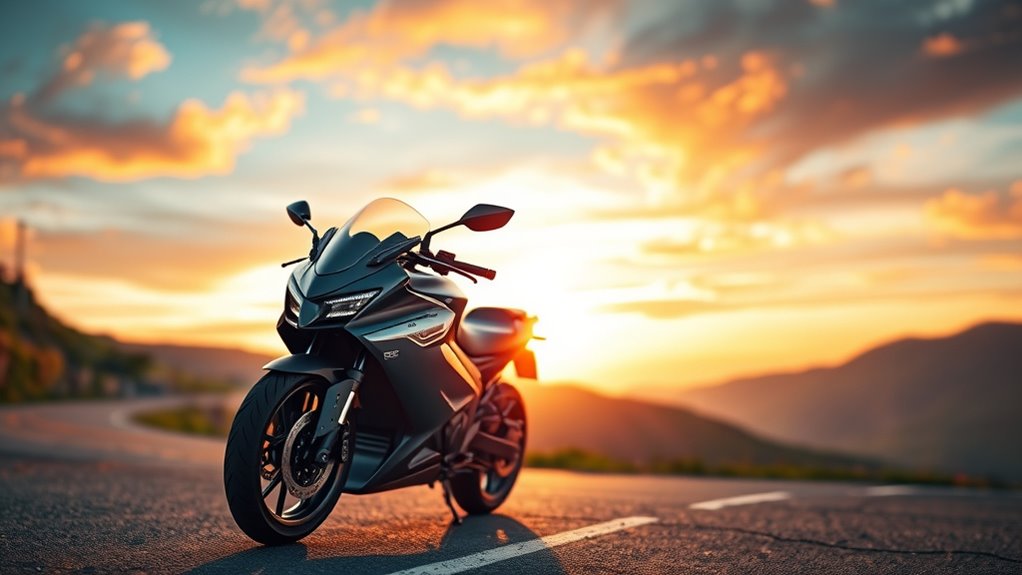
To maximize range without sacrificing performance, focus on riding techniques and bike modifications that improve efficiency. By doing so, you can extend your e-motorbike’s range and battery life while maintaining reliable performance. Here are some strategies:
- Ride at moderate speeds (15–20 mph) to reduce aerodynamic drag and optimize range extension.
- Use pedal assist and coasting during downhill sections to conserve battery power.
- Avoid bursts above 25–30 mph, which consume excess energy and decrease overall range.
- Add aerodynamic modifications, like fairings or a crouched position, to cut wind resistance and boost efficiency.
Implementing these practices helps you get the most out of your e-motorbike without compromising performance, ensuring longer rides with better range.
Frequently Asked Questions
What to Avoid When Buying an Electric Bike?
When buying an electric bike, avoid models with very high wattage motors over 1000W if you have limited terrain or want longer range, as they drain batteries quickly. Steer clear of bikes with small batteries below 360Wh, which require frequent recharging. Also, watch out for bikes without proper speed regulation, poor aerodynamics, or those relying solely on throttle power, all of which can reduce efficiency and cause legal issues.
Is 20 Mph Fast on an E-Bike?
You might wonder if 20 mph is fast on an e-bike, and in many cases, it’s considered a good speed. At this pace, you balance safety, efficiency, and battery life, making it suitable for urban commuting. Riding at 20 mph reduces aerodynamic drag, helping extend your range. Overall, it’s a practical speed for casual and city riding, offering a comfortable and efficient experience without feeling too slow or excessive.
How Do You Maximize the Range of an Ebike?
To maximize your e-bike’s range, ride at moderate speeds between 15-20 mph, as this reduces aerodynamic drag and conserves energy. Use pedal-assist and coasting techniques to lower motor power usage. Keep your tires properly inflated, choose aerodynamic setups, and avoid sudden accelerations or high speeds. Select the lowest effective power assist level and stay within 15-20 mph to prevent unnecessary battery drain, extending your riding distance.
What Is the Range of the 750W Ebike?
Your 750W eBike typically offers a range of 20 to 30 miles at moderate speeds of around 15 mph. If you pedal assist and ride efficiently, you might reach up to 40 miles on a full charge. Keep in mind, factors like rider weight, terrain, and wind can lower or extend this range. For longer rides, plan your route with these variables in mind to maximize distance.
Conclusion
Think of your e-motorbike as a delicate dance between speed and range; pushing too hard at high speeds is like chasing a butterfly—you might catch it briefly, but you’ll tire quickly. Instead, find your rhythm, like a cyclist pacing for a long ride, and you’ll cover more ground comfortably. Remember, by adjusting your speed wisely, you’ll enjoy the journey just as much as the destination—without sacrificing performance or adventure.

